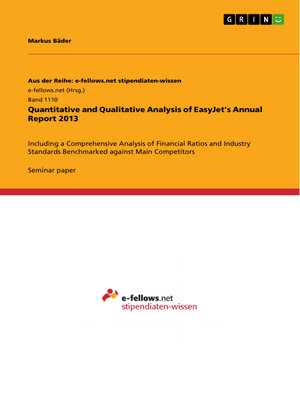Quantitative and Qualitative Analysis of EasyJet's Annual Report 2013
ebook ∣ Including a Comprehensive Analysis of Financial Ratios and Industry Standards Benchmarked against Main Competitors · Aus der Reihe: e-fellows.net stipendiaten-wissen
By Markus Bäder

Sign up to save your library
With an OverDrive account, you can save your favorite libraries for at-a-glance information about availability. Find out more about OverDrive accounts.
Find this title in Libby, the library reading app by OverDrive.



Search for a digital library with this title
Title found at these libraries:
| Library Name | Distance |
|---|---|
| Loading... |
Seminar paper from the year 2015 in the subject Business economics - Accounting and Taxes, grade: 1,0, University of Newcastle, language: English, abstract: Luton-based EasyJet is UK's largest low-cost airline, employing 8,945 people and carrying 61m passengers annually. EasyJet follows Porter's low-cost strategy, effectively distinguishing itself from other LCCs by competing against established flag-carriers at primary European airports. The company streamlines its operations to cost-reduction, facilitated by a strong capital structure.
Europe's airline industry has experienced a structural change since the recession in 2009, with major legacy-carrier continuously reducing their short-haul-capacity. Simultaneously, a KPMG study revealed that the cost gap between traditional and budget airlines has recently shrunk by 30%.
EasyJet's business model distinctly differs from LCC-pioneer Ryanair as the Irish have strategically built a route network focused on serving secondary airports and thereby managed to keep the cost per seat 50% below EasyJet. However the Britons cost-control strategy resulted in a 48% favourable cost base compared to competing legacycarrier such as IAG.







